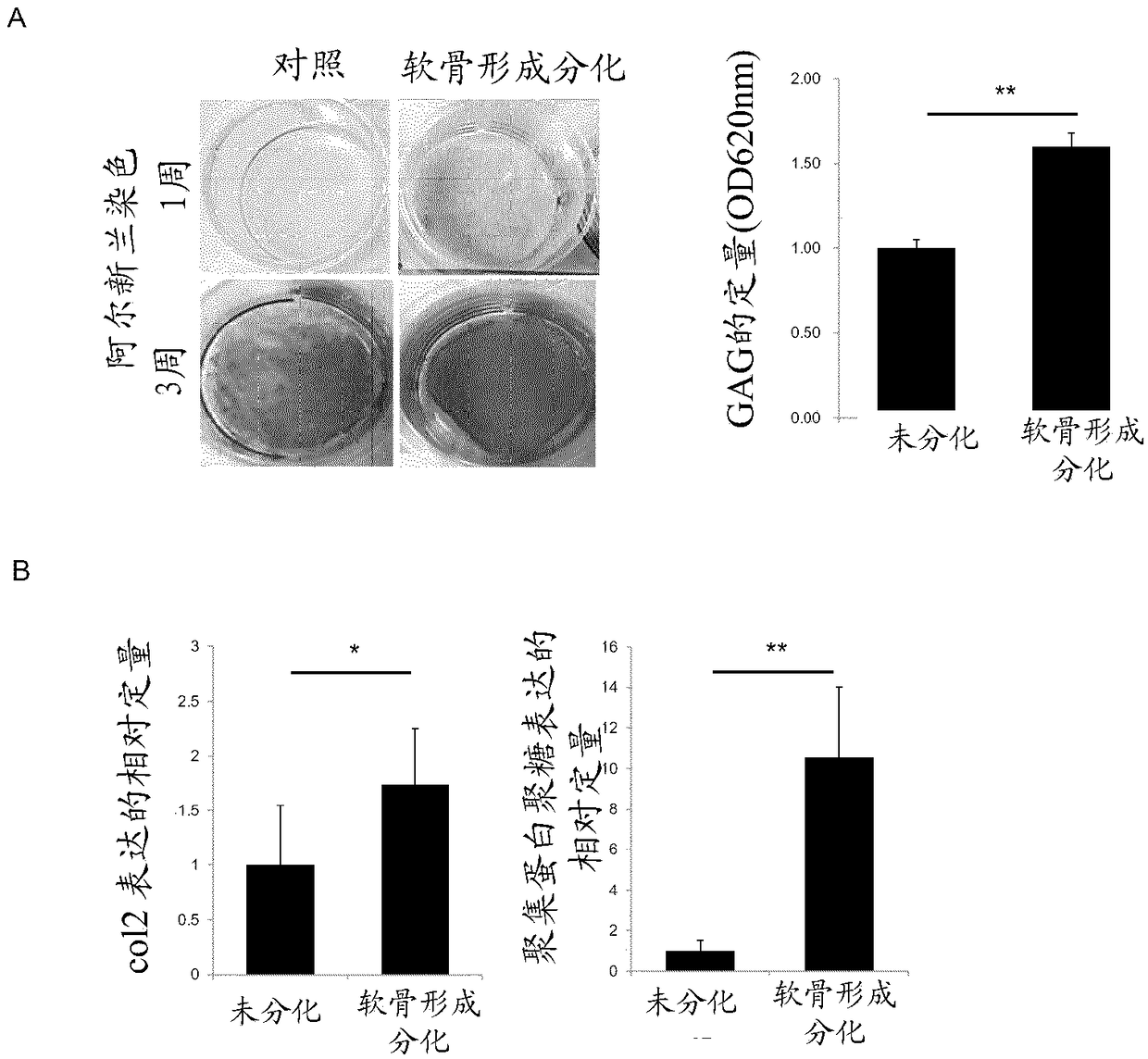A method for preparing 3D cartilage organoid block
An organoid, three-dimensional technology, used in biochemical equipment and methods, medical preparations containing active ingredients, pharmaceutical formulations, etc., can solve problems such as difficult and difficult conventional technology, preparation of therapeutic agents, etc. Compatibility, the effect of increasing biocompatibility
- Summary
- Abstract
- Description
- Claims
- Application Information
AI Technical Summary
Problems solved by technology
Method used
Image
Examples
Embodiment 1
[0032] Example 1. Isolation, Incubation and Stemness Evaluation of Human Mesenchymal Stem Cells
[0033] Adipose tissue was randomly cut into small pieces, and the obtained pieces were washed three times with phosphate-buffered saline (PBS) (Sigma, St. Louis, MO). Then, place small pieces of adipose tissue into a 50 ml conical tube. Add PBS to the tube and stir, then centrifuge. The liquid was discarded, Dubeck's modified Eagle's medium (DMEM) was added to a volume of 50 ml, and the mixture was allowed to react at 37° C. for 90 minutes. After centrifugation at 2,000 rpm for 10 minutes, undissolved adipose tissue suspended in the upper layer was removed. Then, wash with DMEM, centrifuge and remove repeatedly. Separated adipose-derived stem cells were incubated with serum-free stem cell medium (chemically defined medium) at 37°C, 5% CO 2 Incubate and proliferate in an incubator. DMEM containing 10% FBS can be used for proliferation. Proliferating mesenchymal stem cells w...
Embodiment 2
[0034] Example 2, Evaluation of Mesenchymal Stem Cells Differentiation to Cartilage
[0035] Stem cells obtained in 1x10 4 cells / cm 2 Inoculate and inoculate at 37 °C in 5% CO 2 The cells were cultured in an incubator, and the cells were treated with chondrogenic differentiation medium every 2 days in order to differentiate the mesenchymal stem cells into chondrocytes. Chondrogenic differentiation medium contained 50 μg / ml ascorbic acid 2-phosphate, 100 nM dexamethasone, 1% ITS and 10 ng / ml TGF-β1. The level of GAG matrix formation was fixed by treating cells in two-dimensional cartilage plates with 10% formaldehyde for 30 minutes, then cells were treated with 3% acetic acid solution for 3 minutes, followed by staining with 500 μl of Alcian blue solution (pH 2.5) for 30 minutes. Stained samples were washed several times with distilled water and examined microscopically. To obtain quantitative GAG values, Alcian blue-stained plates were treated with 3% acetic acid for 1...
Embodiment 3
[0036] Example 3. Cartilage stimulation using real-time PCR
[0037] To analyze gene modification between undifferentiated stem cells and chondrogenic differentiated cells, the expression of chondrogenic differentiation genes was assessed. For this purpose, ColII and aggrecan were used as gene markers related to chondrocytes, and GAPDH was used as a housekeeping gene. Real-time PCR was performed as follows. That is, cells obtained from each group were washed with PBS, and then they were collected with trypsin-EDTA, and RNA was extracted by the TRIzol (Life Technologies, Inc. Grand Island, NY) method. 1 μg of extracted RNA was used to prepare cDNA and study changes in gene expression. Primer sets and corresponding differentiation markers are shown in Table 1 below.
[0038] Table 1
[0039]
[0040] *NCBI accession number
[0041] The results of the above real-time PCR are shown in figure 2 C. After chondrogenic differentiation, cartilage differentiation indicator ...
PUM
 Login to View More
Login to View More Abstract
Description
Claims
Application Information
 Login to View More
Login to View More - R&D
- Intellectual Property
- Life Sciences
- Materials
- Tech Scout
- Unparalleled Data Quality
- Higher Quality Content
- 60% Fewer Hallucinations
Browse by: Latest US Patents, China's latest patents, Technical Efficacy Thesaurus, Application Domain, Technology Topic, Popular Technical Reports.
© 2025 PatSnap. All rights reserved.Legal|Privacy policy|Modern Slavery Act Transparency Statement|Sitemap|About US| Contact US: help@patsnap.com



